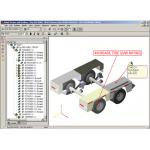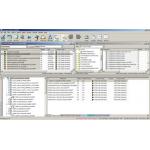Latest News
January 1, 2006
By Jerry Waxler
Many small and mid-sized manufacturers are transitioning from 2D design to 3D modeling with solutions from SolidWorks, Autodesk, and others to design products faster and more efficiently. To make the change smoothly, and actually get products to market quicker, engineers are finding they must be able to convey their models and design intent a dozen different ways: to purchasing, machinists and manufacturing engineers on the shop floor, customers, sales and marketing, and others whose needs overlap with theirs. In fact, many manufacturers who are reaching these goals understand that good data management is key, especially since their MCAD data is particularly demanding, with its multiple formats and interrelated documents.
Such companies are finding that engineering data management (EDM) software like Synergis Adept helps solve data problems within a single software interface when working with 2D and 3D files in SolidWorks, Autodesk, or multi-CAD environments.
Switching to SolidWorks
At Spirax Sarco, for example, a provider of steam heating and processing systems and equipment based in Blythewood,SC, engineers were already using EDM when the time came to convert from 2D design engineering to 3D modeling with SolidWorks. Thus, Spirax Sarco engineers had already leveraged their document management system for revision control, viewing of CAD files by non-technical users, managing CAD and office files, collaborative engineering, and meeting industry specifications.
|
|
| Synergis Adept manages the parts and assemblies for Spirax Sarco’s 3D models, 2D drawings and other engineering office documents. |
“Revision control is absolutely key to locating the most current version,” says Rhonda LaFrance, project manager at Spirax Sarco. “What’s more, having a document management system has helped Spirax Sarco meet ISO certifications. We undergo annual audits. When we moved to South Carolina, we had to get re-certified. It helped to have our EDM system to show auditors how we control engineering documentation.”
The Proving Ground
In today’s competitive marketplace, these challenges faced at Spirax Sarco are common to most small and mid-sized manufacturers. In fact, managing data and streamlining processes have become as much or more of a priority in achieving business success as advancing product design to 3D modeling.
For many companies, large-scale PDM (product data management) or PLM (product lifecycle management) systems do not fit the bill. These organizations need a solution that offers basic functionality at a cost that does not exceed the budget. They also require easy implementation that provides a fast return on investment.
Typically these manufacturers deploy an EDM system like Synergis Adept within engineering where it is most needed. The benefit is that it can be administered and contained within the department without requiring the approval of a committee of senior management. The engineering department tends to be the proving ground for the solution. Once it delivers positive results and gains recognition, it is adopted by other departments where it can easily grow to an enterprise system.
Measure the Benefits
There are many measurable benefits to using EDM in a SolidWorks production environment. With EDM, organizations can:
• Manage thousands of SolidWorks files with part-assembly relationships, while keeping track of the latest revision and “Where Used” information on specific parts
• Effectively organize and manage all SolidWorks product information in a central repository
• Track 3D models, 2D drawings and all engineering related documents between multiple offices dispersed around the globe
• Collaborate and share information beyond engineering without the need for non-engineers to purchase expensive CAD software
• Automate processes to achieve and maintain industry standards and compliances while eliminating manual clerical resources.
Centralizing Searchable Data
One reason data are so important in the SolidWorks environment is because 3D models are composed of complex layers of data, like assemblies, parts, and part configurations—each of which includes associated metadata.
|
|
| EDM systems have built-in viewers so engineers can collaborate and share information with departments that don’t require CAD software. |
SolidWorks uses file properties to store information about each file. These properties generally correspond to the drawing’s title block fields or to physical characteristics (e.g., color, material, finish, etc.) of a 3D model. With this much data inside each file it is difficult and time consuming to access without a centralized and searchable database. The EDM software is able to extract these properties from a model and store them in fields with a database. Once all of the model properties are stored in a database, it is fast and straightforward to search for the name of a file by its metadata—whether a part number, project file number, last owner, etc.
J.F. Taylor, Inc. of Lexington Park, MD, creates high-fidelity flight simulation and training devices for the Department of Defense and uses SolidWorks in conjunction with Synergis Adept. According to Dave Sydnor, vice president of engineering at J.F. Taylor, EDM software improves product design processes because users can find files among thousands of drawings based on specific SolidWorks properties. “These properties can be used to easily and quickly search for drawings and relationships between parts and assemblies,” he says. “Without this feature, an employee would need to manually search and enter information on every drawing.”
Relationships Among Parts and Assemblies
A SolidWorks project consists of a number of files that have relationships to one another. The benefit is that different people can work on different files at the same time. And you can re-use the parts in other assemblies. The challenge lies in tracking the files and all their relationships. An EDM system can save you thousands of hours automating the file tracking system. For example, when SolidWorks files are imported into an EDM system, the program “learns” about the relationships between each SolidWorks file and its externally referenced files. The software then builds a relationship tree that makes it easy for users to find and manage files and related files. These relationships can be managed among files, even after files are moved, edited, or revised. And by tracking file relationships, the EDM software can quickly and easily display “where used” information for any component.
|
|
| An EDM system will manage thousands of SolidWorks files with part-assembly relationships, while keeping track of the latest revision and |
“There are thousands of parts in each of our products, some internal and others supplied by vendors, and parts may be in several different assemblies or subassemblies,” says Sydnor. “Our EDM software can quickly provide us with information about a part and where that part is used.”
Global Dispersement Makes Tracking a Must
Gone are the days when you walked down the hall to the print room to check out a copy of a drawing. But using EDM software, SolidWorks files and related documents can be stored in local or remote locations, and users can access them from one interface, around the clock. The software copies them out of their storage location, and allows other workers to know where the document is. Then when you are done, the EDM software takes care of returning the document to its proper location, without human intervention or chance for error.
Standards Drive Better Processes
Industry standards such as ISO 9001 are becoming more important for a manufacturer’s success, both to improve the efficiency of their process, as well as to win business from customers who expect certification. The burden of implementing such standards lies with keeping track of documents and document processes. Such tracking can, to a large extent, be automated with EDM.
As companies consider ways to remain competitive, they can solve many pressing business issues by taking care of their data. Good data management improves efficiency throughout the organization. And it’s also an insurance policy that can help a company stay flexible and recover quickly from unexpected developments. With businesses merging and moving, and the ever-present possibility of disaster, it’s crucial to have a handle on data. With such an EDM system in place, it is also much easier to respond to sudden change.
Last year, when Spirax Sarco moved its manufacturing facility from Pennsylvania to South Carolina, it had to move documents. Despite the complexity of moving the data, complete with revisions, relationships, and multiple file formats and servers, the company was able to accomplish the task easily by completely moving the engineering department into the new location in one day. The relocation worked without a hitch because of data securely deposited in an EDM system.
“You can’t put a cost on that,” sums up LaFrance. “It’s invaluable.”
Jerry Waxler is the director of technical communications at Synergis Software, which develops Synergis Adept EDM. To comment on this article, send an e-mail by clicking here. Please reference “3D harmony, January 2006” in your message.
PORTER Instrument Gains Control and Compliance
PORTER Instrument Company of Hatfield, PA is a SolidWorks shop that has achieved significant benefit from implementing an EDM system. “Prior to using EDM, SolidWorks files that were normally used as ‘standard parts’ were scattered about on our file server,” says Seth Wolf, supervisor of engineering services for the company. “If we were lucky enough to find a standard part, there was still no way of knowing how many times the part was duplicated at other locations…. With EDM, these standard part files can now be easily searched for, and are all maintained in a single library where everyone has easy and quick access to them.”
“Part of our job in engineering is to communicate, in the best possible way, the concepts that have been put down on paper (or in an electronic file) to various departments throughout the company. Probably the most common requests come from our sales department. If a picture is worth a thousand words, then a picture in a viewer that can manipulate the image in 3D space is worth a million. This means that sales personnel search for and view these files on their own. It no longer requires engineering time to generate 2D graphics files and email them throughout the company.”
PORTER Instrument also uses EDM to achieve and maintain their ISO 9001 certification. “For about 12 years, we’ve been using file management software for 2D CAD, word processing, and spreadsheet applications,” says Wolf. “We’ve been so pleased with it we decided to implement it for SolidWorks. Now, we’re in full compliance with our documentation standards.”—JW
Company Information
J.F. Taylor, Inc.
Lexington Park, MD
PORTER Instrument
Hatfield, PA
SolidWorks Corp.
Concord, MA
Spirax Sarco
Blythewood, SC
Synergis Adept
Synergis Software
Quakertown, PA
Subscribe to our FREE magazine, FREE email newsletters or both!
Latest News
About the Author
DE’s editors contribute news and new product announcements to Digital Engineering.
Press releases may be sent to them via [email protected].









